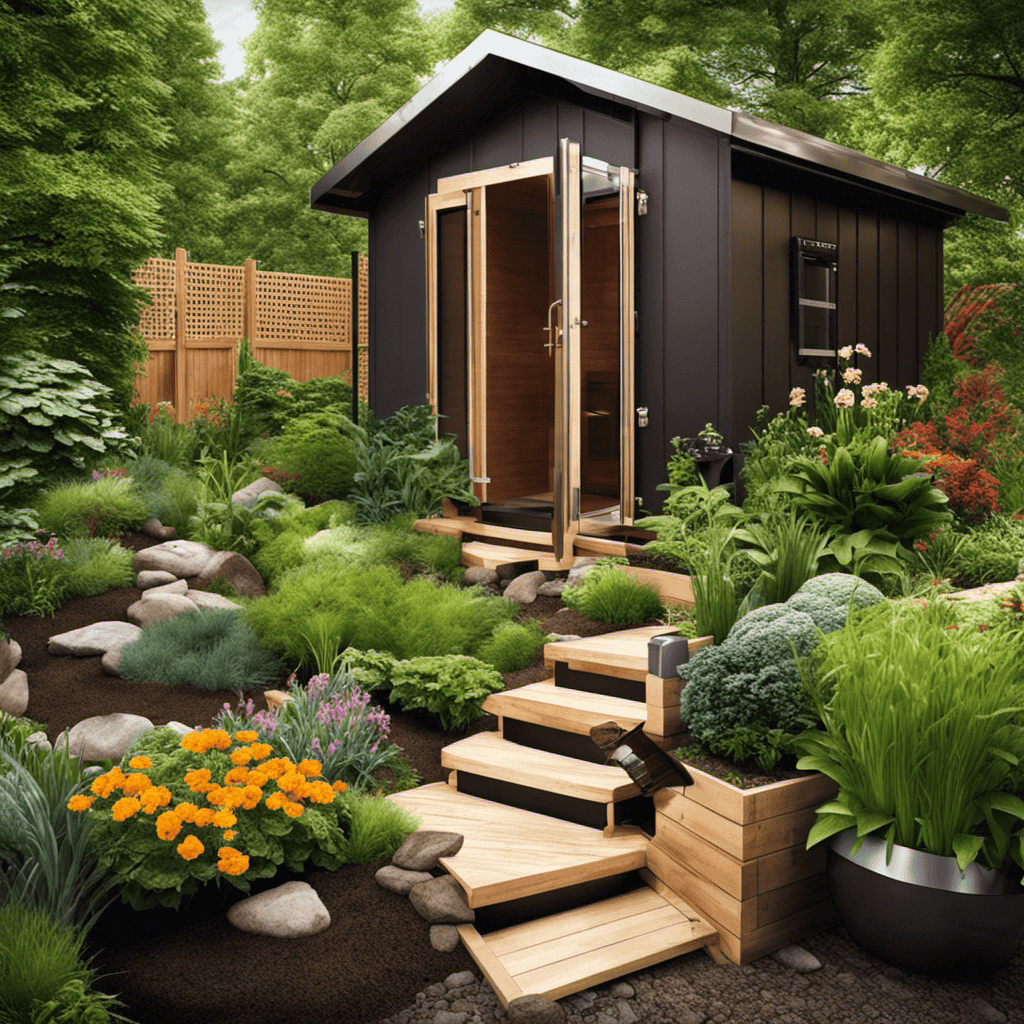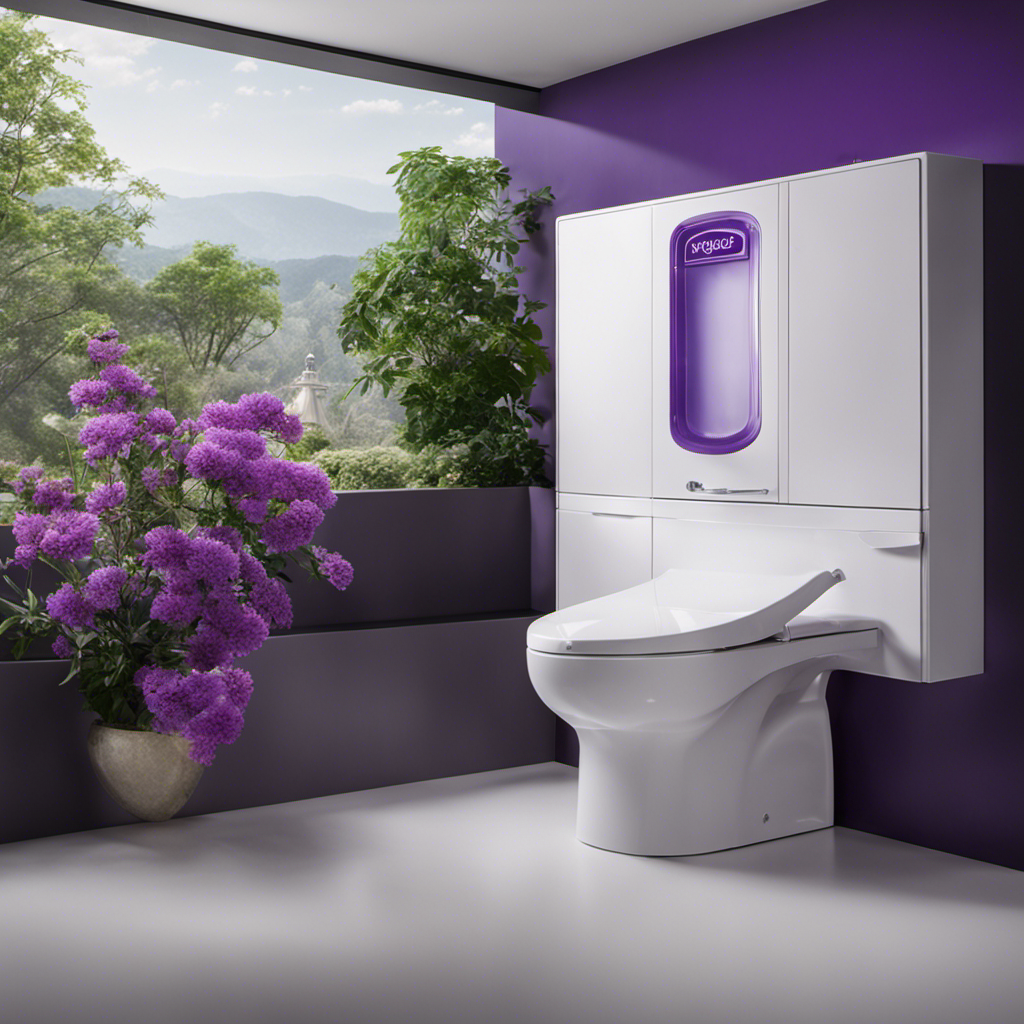Hey there! Did you know that composting toilets are an amazing way to effectively manage waste and contribute to a more sustainable environment?
In this article, I’ll be sharing my top 10 tips for making the most out of composting toilets. From choosing the right system to properly maintaining it, you’ll learn everything you need to know to ensure efficient waste management.
So, let’s dive in and explore the world of composting toilets together!
Key Takeaways
- Choose a suitable location for installation considering ventilation, accessibility, and privacy.
- Follow the manufacturer’s instructions closely to ensure proper installation and sealing of all connections.
- Regularly check and maintain the composting toilet system to ensure its proper functioning.
- Mix organic waste with carbon-rich materials regularly to maintain a balanced carbon-to-nitrogen ratio and promote the growth of beneficial microorganisms.
Choosing the Right Composting Toilet System
I’m currently researching the benefits of using a composting toilet system to ensure proper waste management in my home.
Composting toilets offer several advantages that make them an appealing option for environmentally conscious individuals.
Firstly, they’re a sustainable and eco-friendly alternative to traditional flush toilets. By composting human waste, these systems reduce water consumption and decrease the strain on septic systems.
Secondly, composting toilets produce nutrient-rich compost that can be used as fertilizer for gardens and plants. This natural fertilizer eliminates the need for chemical-based alternatives, promoting healthier soil and plant growth.
Additionally, composting toilets can be installed in areas without access to traditional sewage systems, making them ideal for remote locations or off-grid living.
However, it’s important to be aware of local regulations and guidelines regarding the use of composting toilets to ensure compliance and safe waste management practices.
Proper Installation and Setup
Installing and setting up a composting toilet system requires careful consideration of the available space, materials needed, and specific instructions provided by the manufacturer. Here are some installation tips and troubleshooting tips to ensure a smooth process:
- Determine the ideal location for the composting toilet system, considering factors such as ventilation, accessibility, and privacy.
- Assemble all the necessary materials before starting the installation, including the toilet unit, venting pipes, and composting medium.
- Follow the manufacturer’s instructions closely, as each system may have specific requirements and steps.
- Ensure proper sealing of all connections to prevent any leaks or odors.
- Regularly check and maintain the system, including emptying the composting chamber, monitoring ventilation, and adjusting the composting medium as needed.
Understanding the composting process is essential for the proper functioning of a composting toilet system.
Understanding the Composting Process
Understanding the composting process is essential for effective waste management.
Microorganisms play a crucial role in breaking down organic waste into nutrient-rich compost.
Microorganisms in Composting
Feeding the microorganisms in composting is essential for maintaining an efficient composting process. These microorganisms play a crucial role in breaking down organic matter and turning it into nutrient-rich compost. Here are five key points to understand about the microorganisms’ role in composting:
-
Microorganisms, such as bacteria and fungi, break down the organic waste into simpler compounds through a process called decomposition.
-
These microorganisms require a balanced diet of carbon-rich materials (known as browns) and nitrogen-rich materials (known as greens) to thrive and carry out the composting process effectively.
-
The microorganisms generate heat as they break down the waste, which helps in killing pathogens and weed seeds present in the compost.
-
Adequate moisture levels are crucial for the microorganisms’ survival and activity. Without enough moisture, the composting process may slow down or stop.
-
Oxygen is necessary for the microorganisms to carry out aerobic composting. Proper aeration of the compost pile ensures the microorganisms have enough oxygen to function optimally.
Understanding the microorganisms’ role in composting is essential for achieving successful composting toilet benefits, such as reducing waste volume, minimizing environmental impact, and producing nutrient-rich compost for gardening and agriculture. By providing the right conditions and feeding the microorganisms, we can contribute to effective waste management and a sustainable future.
Organic Waste Breakdown
I actively participate in the organic waste breakdown process by adding nitrogen-rich materials to my compost pile, and I also ensure proper aeration to support the microorganisms’ activity.
Organic waste decomposition is a natural process that involves the breakdown of organic materials, such as food scraps and yard waste, into nutrient-rich compost. Composting benefits are numerous and contribute to sustainable waste management.
Firstly, composting reduces the amount of waste sent to landfills, reducing greenhouse gas emissions and preserving valuable landfill space. It also helps to create nutrient-rich soil, which can be used for gardening and agriculture.
Composting can improve soil structure, water retention, and overall soil health. Additionally, composting reduces the need for synthetic fertilizers, which can have negative environmental impacts.
Nutrient-Rich Compost Production
To ensure nutrient-rich compost production, I regularly mix my organic waste with carbon-rich materials, such as dry leaves and shredded paper. This combination helps to balance the carbon-to-nitrogen ratio in the compost pile, facilitating the breakdown of organic matter and promoting the growth of beneficial microorganisms.
In addition to creating a fertile soil amendment, composting toilets offer several benefits. They help conserve water by reducing the need for traditional flushing toilets, which is especially important in areas with water scarcity. Composting toilets also eliminate the need for sewage systems, reducing the burden on municipal infrastructure.
However, it’s important to be aware of composting toilet regulations to ensure proper usage and disposal. Some regulations may require specific composting methods or prohibit the use of certain materials. By following these regulations, we can ensure safe and effective waste management while reaping the benefits of composting toilets.
- Increased soil fertility
- Reduced water usage
- Decreased reliance on sewage systems
- Elimination of odors
- Lower carbon footprint.
Balancing Carbon and Nitrogen in the Waste
I’m finding it challenging to balance the carbon and nitrogen in the waste for optimal composting in my composting toilet. Maintaining the right carbon to nitrogen ratio is crucial for efficient composting toilet operation.
The ideal ratio is often recommended to be around 30:1, with carbon being the brown, dry materials like sawdust or shredded paper, and nitrogen being the green, wet materials like food scraps or urine. A balanced carbon and nitrogen ratio ensures that the microorganisms responsible for decomposition have enough energy and nutrients to break down the waste effectively.
When the ratio is too high in carbon, decomposition slows down, resulting in a longer composting process. Conversely, too much nitrogen can lead to odors and the risk of nitrogen leaching.
Regular monitoring and adjustment of the carbon and nitrogen inputs in the composting toilet can help maintain efficiency and optimize compost quality.
Managing Moisture Levels
Managing moisture levels is crucial in maintaining an effective composting environment. Excess moisture can lead to anaerobic conditions and unpleasant odors.
Proper ventilation techniques and regular monitoring of moisture levels are key to ensuring a healthy composting process.
Preventing Excess Moisture
I can’t wait to try out these tips for keeping moisture levels in check. It’s important to prevent excess moisture to avoid issues like mold growth and to maintain comfortable humidity levels. Here are some effective ways to control humidity in your space:
-
Use a dehumidifier: Investing in a good quality dehumidifier can help remove excess moisture from the air.
-
Proper ventilation: Ensure that your space has adequate ventilation to allow moisture to escape.
-
Fix leaks: Repair any leaks or water damage promptly to prevent the accumulation of moisture.
-
Monitor indoor plants: Some plants release moisture through transpiration, so be mindful of the number and type of plants you have indoors.
-
Use moisture-absorbing materials: Consider using moisture-absorbing materials like silica gel packs or moisture-absorbing crystals to help reduce humidity.
Proper Ventilation Techniques
Using proper ventilation techniques is crucial for maintaining healthy indoor air quality and preventing moisture buildup.
Ventilation options and airflow management play a significant role in ensuring a comfortable and safe living environment.
Good ventilation helps to remove pollutants, such as allergens, chemicals, and excess moisture, from the indoor air. This helps to reduce the risk of respiratory problems and improve overall air quality.
There are various ventilation options available, including natural ventilation through windows and doors, mechanical ventilation systems like exhaust fans and air purifiers, and hybrid systems that combine both natural and mechanical methods.
Airflow management is essential to ensure proper distribution of fresh air throughout the space and prevent stagnant air or areas with poor ventilation.
Regular maintenance and cleaning of ventilation systems are also important to ensure their effectiveness in providing adequate airflow and maintaining good indoor air quality.
Maintaining Optimal Composting Environment
One key tip for maintaining an optimal composting environment is to regularly monitor and adjust moisture levels to ensure the compost stays moist but not overly wet. This is crucial for promoting microorganism activity and maximizing composting efficiency.
Here are five important factors to consider when managing moisture levels in your compost:
-
Use a moisture meter to regularly check the moisture content of your compost pile.
-
Keep the compost pile covered to prevent excess moisture from rain or irrigation.
-
If the compost becomes too wet, add dry materials such as leaves or straw to absorb the excess moisture.
-
Conversely, if the compost is too dry, water it lightly using a hose or watering can.
-
Remember that the ideal moisture range for composting is around 40-60%, which can be achieved by maintaining a balance between wet and dry materials.
Regular Turning and Mixing of the Compost
To maintain optimal compost decomposition, it’s important to regularly turn and mix the pile. Compost turning and mixing help to enhance the decomposition process by providing oxygen and promoting the breakdown of organic materials.
When we turn the compost pile, we introduce oxygen into the mixture, which is essential for the growth of aerobic bacteria that break down the waste. Mixing the pile ensures that all the materials are evenly distributed, preventing the formation of anaerobic pockets that can lead to unpleasant odors and slow decomposition.
Additionally, turning and mixing the compost helps to distribute moisture evenly throughout the pile, ensuring that the microorganisms responsible for decomposition have the ideal conditions for their activity.
Regularly turning and mixing the compost pile is therefore crucial for achieving efficient and effective composting.
Monitoring and Adjusting Temperature
I can monitor and adjust the temperature of the compost pile by regularly checking the thermometer and making necessary adjustments. Temperature control is crucial in the composting process as it affects the decomposition rate and the breakdown of organic matter.
Here are some key points to consider when it comes to temperature control in composting toilet design:
- Maintain the temperature between 110°F and 160°F for efficient decomposition.
- Use insulation materials to help retain heat and regulate temperature fluctuations.
- Monitor moisture levels as excessive moisture can lead to cooling of the compost pile.
- Turn the compost regularly to distribute heat and ensure even decomposition.
- Add bulking agents such as sawdust or wood chips to help regulate temperature and improve airflow.
By carefully monitoring and adjusting the temperature, we can create an ideal environment for the breakdown of waste in composting toilets. This plays a vital role in ensuring successful composting and minimizing any potential issues, such as odor.
Speaking of odor control…
Dealing With Odor Control
Dealing with odor control is an important aspect of waste management in composting toilets. There are several techniques to eliminate odors, both natural and technological.
Odor Elimination Techniques
The key to effective odor elimination techniques is maintaining proper ventilation in the composting toilet. When it comes to keeping unpleasant smells at bay, there are a few strategies that can help.
Here are some tips to consider:
-
Use natural odor eliminators: Adding materials like sawdust, coconut coir, or peat moss to the toilet can help absorb odors and promote composting.
-
Regularly empty the waste container: Keeping the waste container empty prevents the buildup of odor-causing compounds.
-
Ensure proper moisture levels: Maintaining the right moisture balance in the composting toilet can help prevent the growth of odor-producing bacteria.
-
Maintain a balanced carbon-to-nitrogen ratio: The proper ratio of carbon-rich materials (like sawdust) to nitrogen-rich materials (like food waste) helps promote efficient composting and reduces odors.
-
Install a ventilation system: A well-designed ventilation system can effectively remove odors from the composting toilet and keep the air fresh.
Natural Remedies for Odor
One effective way to control odor naturally is by using essential oils or vinegar, which can be easily incorporated into your odor elimination routine.
Natural air fresheners and DIY odor neutralizers can help create a pleasant environment while avoiding the use of harsh chemicals.
Essential oils such as lavender, lemon, and tea tree oil have antimicrobial properties that can help eliminate odors. Simply mix a few drops of your favorite essential oil with water in a spray bottle and mist it around the room.
Vinegar, on the other hand, is known for its ability to neutralize odors. You can create a DIY vinegar spray by combining equal parts vinegar and water, and using it to clean surfaces or spray it in the air.
These natural remedies aren’t only effective in eliminating odors, but they’re also safe for you and the environment.
Harvesting and Using Compost
I love harvesting and using compost in my garden to nourish the soil and promote healthy plant growth. Compost is a valuable resource that can be easily made from organic waste materials, such as kitchen scraps, yard trimmings, and leaves. Here are five important techniques and tips for harvesting and utilizing compost effectively:
- Regularly turn the compost pile to ensure proper aeration and decomposition.
- Use a compost thermometer to monitor the temperature and ensure optimal conditions for decomposition.
- Mix different types of organic materials to achieve a balanced compost mix.
- Add water to maintain the moisture level in the compost pile.
- Allow the compost to mature for at least six months before using it in the garden.
By following these harvesting techniques and utilizing compost properly, you can create nutrient-rich soil amendments that will enhance your garden’s productivity.
Now let’s move on to maintenance and troubleshooting tips to ensure successful composting.
Maintenance and Troubleshooting Tips
To effectively maintain and troubleshoot my composting system, I regularly check the moisture levels and temperature using a thermometer. These troubleshooting techniques are essential for ensuring the success of the composting process.
In addition to monitoring the moisture and temperature, there are other maintenance strategies that can be employed. Regularly turning the compost pile helps to aerate it and promote decomposition. It’s also important to ensure a proper balance of green and brown materials, as an imbalance can lead to odors or slow decomposition.
Adding a compost activator or accelerator can help speed up the process. Finally, regularly inspecting the composting system for any signs of pests or diseases is crucial.
Frequently Asked Questions
Can Composting Toilets Be Used in All Types of Climates?
Composting toilets can be used in a variety of climates, including extreme ones. However, they do require some maintenance in different climates to ensure optimal performance.
For example, in colder climates, it may be necessary to insulate the toilet or provide additional heat to prevent freezing.
In hotter climates, proper ventilation and moisture control are important to prevent odors and promote composting.
What Are the Benefits of Using Composting Toilets Over Traditional Flush Toilets?
Using composting toilets instead of traditional flush toilets has several benefits.
Firstly, composting toilets help in waste management by converting human waste into nutrient-rich compost. This compost can be used as a natural fertilizer for gardens and plants.
Additionally, composting toilets save water since they don’t require flushing. They’re also more environmentally friendly as they reduce the need for sewage systems and the associated energy costs.
In comparison to traditional flush toilets, composting toilets offer a sustainable and eco-friendly solution for waste disposal.
Are There Any Health Risks Associated With Using Composting Toilets?
Health risks associated with using composting toilets are minimal. The proper management and maintenance of composting toilets can help prevent any potential health issues. Composting toilets are designed to contain and break down waste, reducing the risk of odor and bacteria.
Additionally, composting toilets have a positive environmental impact, as they save water and reduce the need for sewage treatment.
Overall, composting toilets provide a safe and sustainable alternative to traditional flush toilets.
How Long Does It Take for the Waste to Fully Compost in a Composting Toilet System?
In a composting toilet system, the waste composting timeline can vary depending on several factors. The size of the system, the temperature, and the type of waste all play a role in how long it takes for the waste to fully compost.
Regular composting toilet maintenance, such as turning the compost and ensuring proper moisture levels, can help speed up the process.
It’s important to follow guidelines and recommendations for optimal composting in order to effectively manage waste in composting toilets.
Are There Any Specific Regulations or Permits Required for Installing a Composting Toilet System in Residential Areas?
Regulations and permits vary for installing a composting toilet system in residential areas. Local building codes and health department regulations typically govern these installations. It’s essential to research and comply with the specific requirements of your area.
Contacting the local authorities or a professional installer can provide guidance on obtaining necessary permits and ensuring compliance with regulations. It’s important to follow these guidelines to ensure a safe and legal installation of a composting toilet system in residential areas.
Conclusion
In conclusion, effective waste management using composting toilets requires careful consideration and proper maintenance.
By choosing the right system, understanding the composting process, and managing moisture levels, odor control, and temperature, you can successfully convert waste into valuable compost.
Remember, ‘where there’s muck, there’s brass!’
So take the necessary steps to ensure a sustainable and environmentally-friendly approach to waste management.










